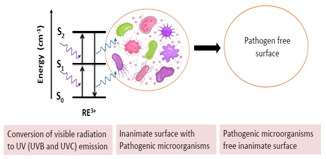Rare-Earth Doped Upconverting Nanophosphors for Light-Mediated Biocidal Surface Development
DOI:
https://doi.org/10.54162/SD01-25201/02Keywords:
Rare earth elements, Nanophosphors, UpconversionAbstract
Since the earliest civilization, diminishing the occurrence and subsequent transmission of pathogenic microorganisms in the indoor environment has been one of the utmost priorities to the human society. In line with intensive research towards the surface disinfection through the use of several photocatalytic processes, rare-earth doped upconverting nanophosphors (UCNPs) have recently drawn a great attention on the basis of their purely optical phenomenon of directly converting visible light into germicidal ultraviolet radiation (namely ultraviolet C) via the unique photoluminescence process namely ‘upconversion’. The efficient upconversion of abundant visible light into ultraviolet photons in the germicidal range and, consequently, effective biocidal action while coated onto surfaces enable UCNPs as a potential candidate to be used for inhibiting germ spreading through the inanimate surface in public places, hospitals and so forth.

Downloads
Published
Issue
Section
License
All articles published in Science Dialectica are licensed under a Creative Commons License. The specific license applied to an article depends on the author's agreement during submission. Our journal supports the following licensing terms:
Creative Commons Attribution (CC BY): This license allows others to distribute, remix, adapt, and build upon the work, even commercially, as long as proper credit is given to the original authors.
Creative Commons Attribution-NonCommercial (CC BY-NC): This license allows others to remix, adapt, and build upon the work for non-commercial purposes, with proper attribution.
Creative Commons Attribution-NonCommercial-NoDerivatives (CC BY-NC-ND): This license allows sharing of the work for non-commercial purposes, but it cannot be modified or used commercially.
By default, all published articles are made available under the CC BY-NC license unless otherwise specified. Authors can request alternative licensing during submission.
For more information, visit the Creative Commons licensing page or contact us at contact@sciencedialectica.com

